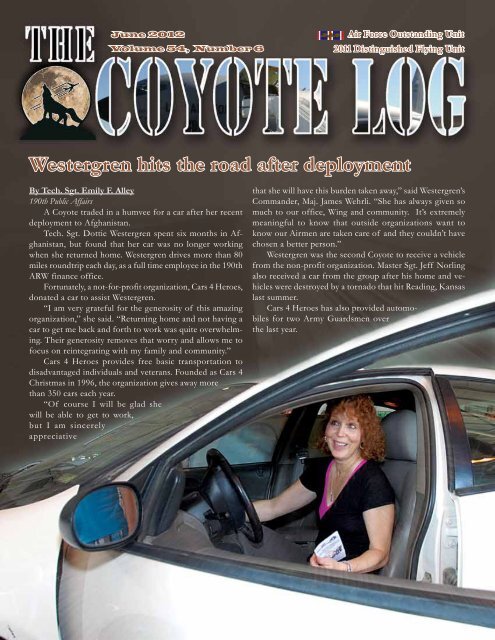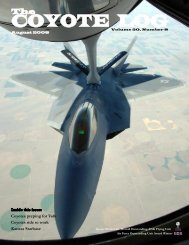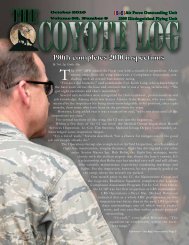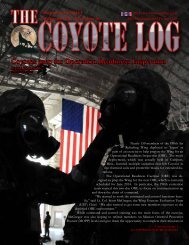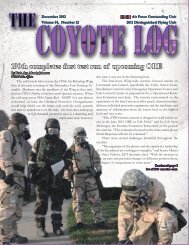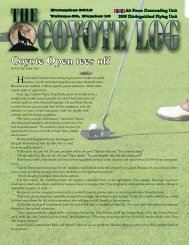Westergren hits the road after deployment - 190th Air Refueling ...
Westergren hits the road after deployment - 190th Air Refueling ...
Westergren hits the road after deployment - 190th Air Refueling ...
You also want an ePaper? Increase the reach of your titles
YUMPU automatically turns print PDFs into web optimized ePapers that Google loves.
June 2012Volume 54, Number 6<strong>Air</strong> Force Outstanding Unit2011 Distinguished Flying Unit<strong>Westergren</strong> <strong>hits</strong> <strong>the</strong> <strong>road</strong> <strong>after</strong> <strong>deployment</strong>By Tech. Sgt. Emily F. Alley<strong>190th</strong> Public AffairsA Coyote traded in a humvee for a car <strong>after</strong> her recent<strong>deployment</strong> to Afghanistan.Tech. Sgt. Dottie <strong>Westergren</strong> spent six months in Afghanistan,but found that her car was no longer workingwhen she returned home. <strong>Westergren</strong> drives more than 80miles roundtrip each day, as a full time employee in <strong>the</strong> <strong>190th</strong>ARW finance office.Fortunately, a not-for-profit organization, Cars 4 Heroes,donated a car to assist <strong>Westergren</strong>.“I am very grateful for <strong>the</strong> generosity of this amazingorganization,” she said. “Returning home and not having acar to get me back and forth to work was quite overwhelming.Their generosity removes that worry and allows me tofocus on reintegrating with my family and community.”Cars 4 Heroes provides free basic transportation todisadvantaged individuals and veterans. Founded as Cars 4Christmas in 1996, <strong>the</strong> organization gives away morethan 350 cars each year.“Of course I will be glad shewill be able to get to work,but I am sincerelyappreciativethat she will have this burden taken away,” said <strong>Westergren</strong>’sCommander, Maj. James Wehrli. “She has always given somuch to our office, Wing and community. It’s extremelymeaningful to know that outside organizations want toknow our <strong>Air</strong>men are taken care of and <strong>the</strong>y couldn’t havechosen a better person.”<strong>Westergren</strong> was <strong>the</strong> second Coyote to receive a vehiclefrom <strong>the</strong> non-profit organization. Master Sgt. Jeff Norlingalso received a car from <strong>the</strong> group <strong>after</strong> his home and vehicleswere destroyed by a tornado that hit Reading, Kansaslast summer.Cars 4 Heroes has also provided automobilesfor two Army Guardsmen over<strong>the</strong> last year.
Thunderchief returns to KansasBy Senior Master Sgt. Kevin Drewelow<strong>190th</strong> Maintenance GroupThanks to <strong>the</strong> hard work of six KansasCoyotes, a former 184th Tactical FighterTraining Group (TFTG) fighter bomberhas been saved from <strong>the</strong> scrap heap andwill soon be displayed at <strong>the</strong> Museum of<strong>the</strong> Kansas National Guard at Forbes Field.Master Sgt. Steve Anderson, <strong>190th</strong>Logistics Readiness Squadron, Master Sgt.Shad England, <strong>190th</strong> Maintenance Group,and <strong>190th</strong> Maintenance Group’s MasterSgt. Marvin Stadler, Tech. Sgt. Randy Hansenand <strong>Air</strong>man 1st Class Neal McKinzieaccompanied Senior Master Sgt. Alan Laubto San Antonio Texas in mid-April to begin<strong>the</strong> move.The 433rd <strong>Air</strong>lift Wing provided acrane and support to help <strong>the</strong> team disassemble,load and transport <strong>the</strong> RepublicF-105D Thunderchief to Forbes. Laub,Stadler, Hansen and Staff Sgt. Jared Petefish,<strong>190th</strong> MXG, prepared <strong>the</strong> jet for finaldisassembly by removing parts and panelsduring a previous visit.“Thanks to its smaller wing, <strong>the</strong>Thunderchief was easier to disassembleand move than was <strong>the</strong> Canberra,” Laubsaid, referring to <strong>the</strong> former <strong>190th</strong> EB-57Bhe and a team trucked from California toKansas. “The F-105 attracted a lot of attentionon <strong>the</strong> highway.”Hansen, a former 184th Jayhawk,helped restore a Thunderchief in 1983 atMcConnell <strong>Air</strong> Force Base in Wichita, Kan.“Working on this jet reminded me of allof <strong>the</strong> F-105 people I worked with at <strong>the</strong>184th. This will be a great addition to <strong>the</strong>Museum of <strong>the</strong> Kansas National Guard,”he said.The 184th TFTGoperated 30 RepublicF-105 Thunderchiefsfrom 1971-1979 andwas responsible fortraining all <strong>Air</strong> Force,Guard and Reservecrews, a mission <strong>the</strong>ycontinued through twoo<strong>the</strong>r aircraft types until<strong>the</strong>y converted toB-1 bombers in 1994.Republic <strong>Air</strong>craftdesigned <strong>the</strong> F-105 in <strong>the</strong> ‘50s to deliver anuclear weapon at high speed and low altitude,but <strong>the</strong> Thunderchief made its markon <strong>Air</strong> Force history as a fighter bomberover Sou<strong>the</strong>ast Asia from 1964 to 1970.It flew more combat missions overNorth Vietnam than any o<strong>the</strong>r aircraft,but paid a terrible price with nearly 400lost in action. In air-to-air combat, F-105slost 22 of <strong>the</strong>ir own while shooting down28 enemy fighters.The factory delivered F-105D tailnumber 61-0106, <strong>the</strong> Museum’s aircraft,to <strong>the</strong> <strong>Air</strong> Force in 1962. The jet served inEurope and Libya until 1967 when <strong>the</strong> <strong>Air</strong>Force sent it to McConnell to train Thunderchiefcrews. The <strong>Air</strong> Force transferred<strong>the</strong> F-105 schoolhouse mission to <strong>the</strong>184th in 1971 and 61-0106 joined <strong>the</strong> Kansas<strong>Air</strong> National Guard a year later. After<strong>the</strong> 184th converted to <strong>the</strong> F-4 Phantom in1979, 61-0106 joined <strong>the</strong> <strong>Air</strong> Force Reserveat Hill AFB where it ended its flying days in1983. 61-0106 was one of a dozen F-105sflown to Lackland AFB where <strong>the</strong>y wereused to train security forces on a simulatedflight line.The <strong>Air</strong> Force recently relocated <strong>the</strong>training area and released a few Thunderchiefs,including 61-0106 to museums.Local aviation enthusiast Robert Eichkornsent photos of <strong>the</strong> Lackland F-105s toSenior Master Sgt. Kevin Drewelow, 190MXG and a member of <strong>the</strong> Museum of<strong>the</strong> Kansas National Guard board ofdirectors. Drewelow <strong>the</strong>n sent <strong>the</strong> photosto retired <strong>190th</strong> photographer SeniorMaster Sgt. Jerry Geer, who confirmedthat 61-0106 had belonged to <strong>the</strong> 184th.The Museum of <strong>the</strong> Kansas NationalGuard and <strong>190th</strong> <strong>the</strong>n worked with <strong>the</strong>Museum of <strong>the</strong> United States <strong>Air</strong> Forceto obtain 61-0106 for <strong>the</strong> Kansas museumcollection.Volunteers will remark 61-0106 as itappeared during its service with <strong>the</strong> 184thTFTG. The completed Thunderchief willhonor those who served in <strong>the</strong> 184th during<strong>the</strong> F-105 era and contributed so muchto <strong>the</strong> nation and <strong>the</strong> state of Kansas.3
6Portrait of an <strong>Air</strong>man<strong>Air</strong>man First Class Jeni D. DouglasBy The <strong>190th</strong> Safety Office<strong>190th</strong> <strong>Air</strong> <strong>Refueling</strong> Wing(Note: this is <strong>the</strong> second part of a multieditionfeature on <strong>the</strong> summer safety.)Drinking has become a part ofmany summer pastimes – before, duringand <strong>after</strong>. While most people are awareof <strong>the</strong> hazards of drinking and driving,<strong>the</strong>re are many more situations wherealcohol becomes a danger. Consider<strong>the</strong> consequences before you begin yoursummer fun; your safety, as well as <strong>the</strong>safety of o<strong>the</strong>rs, will depend on yourclear thinking.Alcoholic drinks have differentamounts of alcohol in <strong>the</strong>m and alcoholgets into your bloodstream quickly. Beeris about 5 percent alcohol, althoughdarker beers and ales can have more.Wine is usually 12 – 15 percent alcohol,while hard liquor is about 45 percentalcohol.The amount and type of food inyour stomach can change how quicklyalcohol enters your bloodstream. Forexample, high-carbohydrate and highfatfoods can make your body absorbJob Title: Optometrist ApprenticeResponsibilities: Patient care and testing; fitting, ordering and dispensing ofmilitary eyewear.Education: Majoring in ecology and evolutionary biology at <strong>the</strong> University ofKansas.Military Experience: Graduating in <strong>the</strong> top 10 percent of ophthalmic technicalschool in 2010.Goals and Ambitions: Traveling <strong>the</strong> world, learning about culture and appreciatingnature.Hobbies and Activities: Laughing with my friends and family and anthingoutdoors.Most Memorable <strong>190th</strong> Moment: Being recognized for my work, thanks tomy awesome supervisor, Col. Hefner. That gave me more confidence in myposition.Sober is safer: Thinking <strong>the</strong>n drinkingalcohol more slowly.Some alcoholic drinks get into yourbloodstream faster. A carbonated (fizzy)alcoholic drink, such as champagne,will be absorbed faster than a noncarbonateddrink.Alcohol slows your breathing rate,heart rate, and how well your brainfunctions. These effects may appearwithin 10 minutes and peak at around40 - 60 minutes. Alcohol stays in yourbloodstream until it is broken downby <strong>the</strong> liver. The amount of alcohol inyour blood is called your “blood alcohollevel.” If you drink alcohol faster than<strong>the</strong> liver can break it down, this levelwill rise.Your blood alcohol level is used tolegally define whe<strong>the</strong>r or not you are“drunk.” The blood alcohol legal limitusually falls between 0.08 and 0.10 inmost states. Below is a list of bloodalcohol levels and <strong>the</strong> likely symptoms.--0.05 -- reduced inhibitions--0.10 -- slurred speech--0.20 -- euphoria and motor impairment--0.30 -- confusion--0.40 -- stupor--0.50 -- coma--0.60 -- respiratory paralysis and deathDevelop your plan before ra<strong>the</strong>rthan <strong>after</strong> and stick to it. Whe<strong>the</strong>r it’shaving a designated driver or choosingto stay sober while you participatein outdoor activities, you will have funknowing you’ve taken steps to preventinjury or death.The Combat <strong>Air</strong> Museum in Topekawill be hosting an open house for <strong>190th</strong>members and families on Saturday,June 12 from10am to 2pm.Admission is free.
For Your InformationPromotionsAIRMAN FIRST CLASSRoss G. Ackley, FSSJeremy L. Young, CESENIOR AIRMANSarah A. Coffey, LRSTECHNICAL SERGEANTLindsey S. Lutgen, SFSJoseph J. Palmer, MDGJesse R. Price, MXSMASTER SERGEANTDaniel E. Davies, Jr., AMXSSarah R. Sell, SFSJ. Scott Ullmer, AMXSCAPTAINDavid K. Bailey, 117thCoyote GrillJune UTA MenuAppointments/EnlistmentsAB Nicholas T. Buckner, LRSEnlistment Date: April 12, 2012AB Joshua A. Gee, SFSEnlistment Date: April 14, 2012AB Dustin M. Plankey, MDGEnlistment Date: April 12, 2012AB Chase R. Wechsler, Student FlightEnlistment Date: April 14, 2012190 AMXSFirst SergeantVacancyThe <strong>190th</strong> <strong>Air</strong>craft MaintenanceSquadron First Sergeantposition is open to promotableTech. Sgts. and Master Sgts. Applicantsmust have ASVAB score of 41 administrativeor 62 general, and a passingfitness assessment. If interested, submityour package to Chief Master Sgt. IvanPerez by COB June 3, 2012.First Sergeant package consists of:- Resume with cover letter- Current RIPCongratulations to <strong>the</strong>Outstanding <strong>Air</strong>men of <strong>the</strong> 2ndQuarter 2012 and Company GradeOfficer of 2011!RetirementsLt. Col. John Kerns, <strong>190th</strong> ARWRetirement Date: March 1, 2012CMSgt. Danny Roush, CESRetirement Date: March 14, 2012SMSgt. Clifford Archer, MDGRetirement Date: May 25, 2012SMSgt. Richard Smith, FMRetirement Date: April 1, 2012SMSgt. Michael Swed, AMXSRetirement Date: February 15, 2012MSgt. John Blackwell, 127th WFRetirement Date: March 7, 2012MSgt. Wallace Bonnette, LRSRetirement Date: February 20, 2012TSgt. Richard Rust, MXSRetirement Date: April 15, 2012OutstandingPerformersA1C Erica Davisof <strong>the</strong> MaintenanceSquadron received <strong>the</strong> ACEaward for outstanding academicachievement while attending <strong>the</strong>Comm/Nav System ApprenticeCourse. She also earned <strong>the</strong> “Thunderbolt”recognition for exceedingBMT fitness standards with a compositescore of 90% or above.Friday, June 1Boneless crispy baked chicken,pork chops & mushroom gravy,macaroni & cheese casserole,steamed broccoli, cherry crisp andspice cakeSaturday, June 2Fajitas, fried catfish, cheesy potatoes,corn, pollockSunday, June 3Pepper steak, hickory grilled chickenbreast, au gratin potatoes, darkchocolate cake, rolls & butter<strong>Air</strong>man Category:SrA Elizabeth PollardNCO Category:SSgt Michael TremblaySNCO Category:SMSgt Denise Montgomery2011 CGO of <strong>the</strong> Year:Capt. Penny JamvoldChaplain ServicesAll services are in building 662, third floornext to <strong>the</strong> STARBASE classroom onSundays of <strong>the</strong> UTA.Protestant @ 8 a.m.Church of Latter Day Saints @ 11 a.m.Catholic confession @ 1:30 p.m.Catholic mass @ 1:45 p.m.Maintenance Jobs Available-2 traditional positions-Requires 2A571 AFSCApplicants will:-Report/track aircraft status-Use GO-81-Communicate well-Use radios-Dispatch personnel/equipmentThis position is:-Opportunity to travel/deploy-Mission essentialTo apply:Submit your military resume to ChiefCoffin, MOF Superintendent.Email mickel.coffin @ang.af.mil7
Coyote Heritage<strong>Air</strong>craft “641” gets ready to buttonup prior to leaving on a rotation insupport of Operation Desert Shield toJeddah, Saudi Arabia, sometime in lateNovember of 1990.Prior to activation of <strong>the</strong> 117th at<strong>the</strong> end of December 1990, <strong>the</strong> <strong>Air</strong> NationalGuard relied on volunteers andits own steady flow of parts and aircraftto keep <strong>the</strong> effort going forward.The <strong>190th</strong> had been <strong>the</strong> first guardunit to respond to <strong>the</strong> call for volunteersand aircraft, but it soon becameapparent that without support from <strong>the</strong>regular <strong>Air</strong> Force, which was alreadytasked to <strong>the</strong> limit, keeping up with demand would create challenges. Guard tanker people and parts would have to sortit out <strong>the</strong>mselves. The solution that evolved was a weekly rotation of KC-135s, using tankers from all Guard units. The<strong>190th</strong>, and Forbes Field, was <strong>the</strong> coordinating unit.Almost from <strong>the</strong> beginning, <strong>the</strong>re was a steady stream of tankers flying to Jeddah and back, with <strong>the</strong> incoming tankerlanding <strong>the</strong> same time <strong>the</strong> outbound tanker was taking off. It would become one of <strong>the</strong> most interesting aspects of <strong>the</strong><strong>Air</strong> National Guard’s involvement in <strong>the</strong> Gulf War.<strong>Air</strong> refueling out of Jeddah was primarily a Guard operation, with <strong>the</strong> <strong>190th</strong> leading <strong>the</strong> way.Please record your story and send it to <strong>the</strong> historian’s office at: <strong>190th</strong> Historian, 5920 SE Coyote Dr., Topeka, KS 66619-5370.The Coyote Log<strong>190th</strong> ARW Public Affairs5920 SE Coyote DriveForbes Field (ANG)Topeka, KS 66619-5370OFFICIAL BUSINESSFIRST CLASSMAILUS POSTAGEPAIDPERMIT NO 171TOPEKA KSMoving? Don’t forget to update your address:Military Members: visit vMPF to update your address.Retirees & Civilians: email 190ARW.PA.CoyoteLog@ang.af.mil. Please allow 2-3 months for updates toreflect on your log.To The Coyote Family of:


